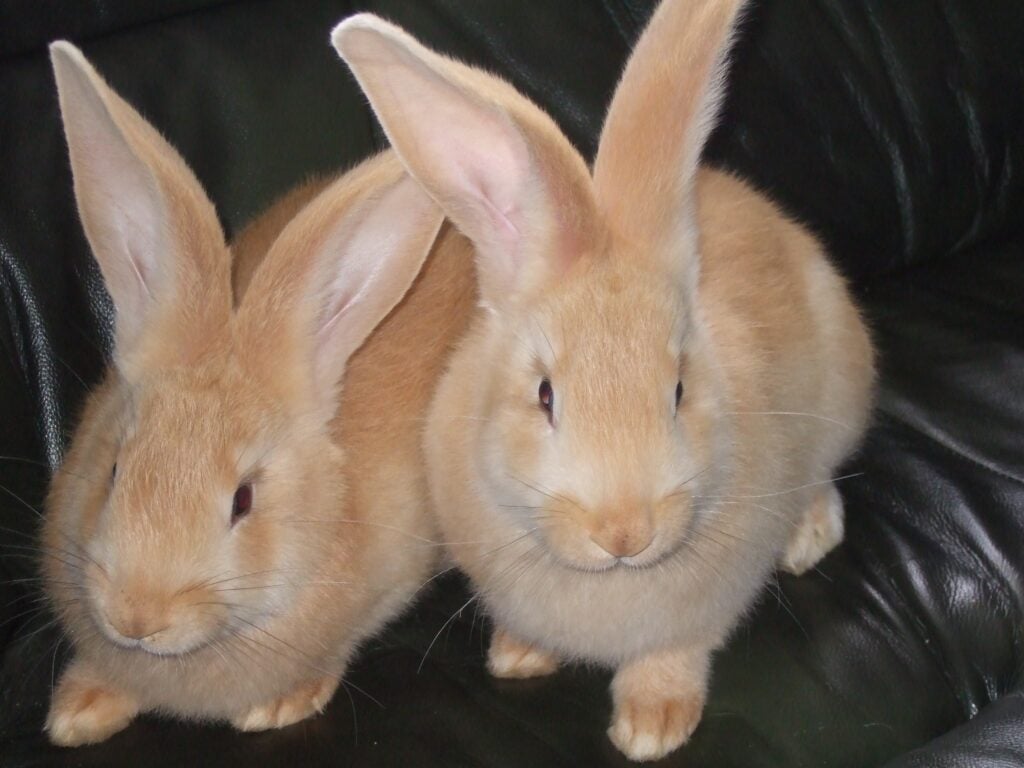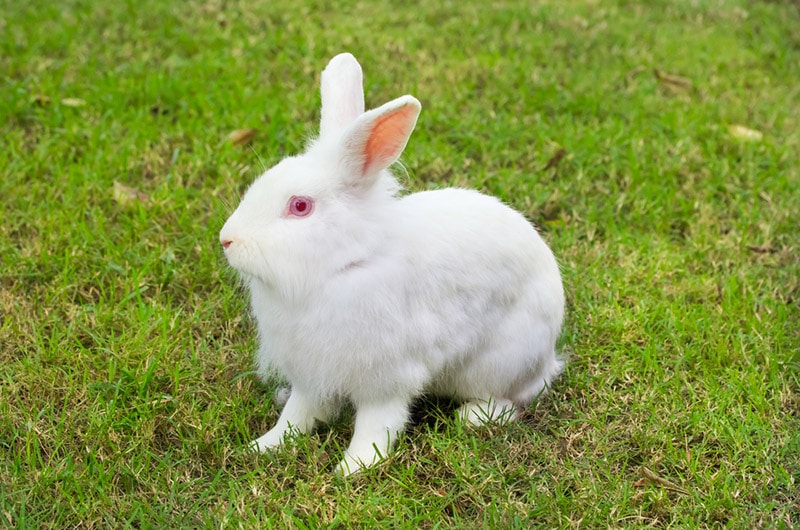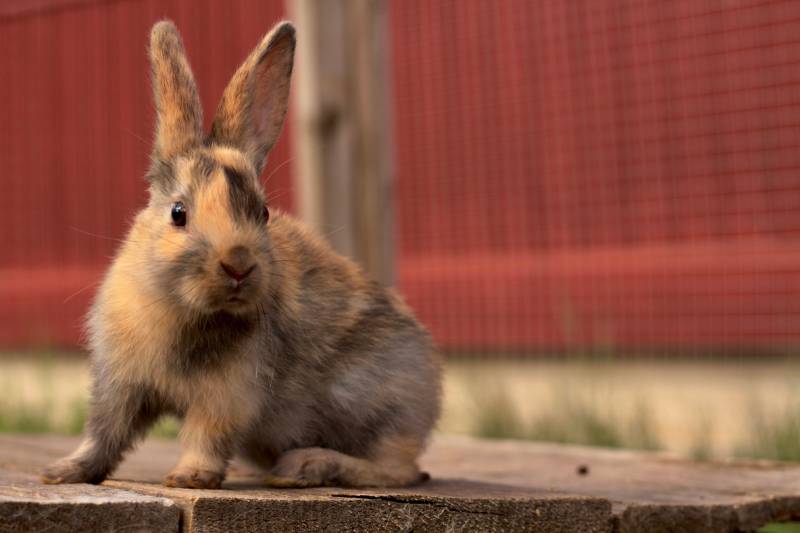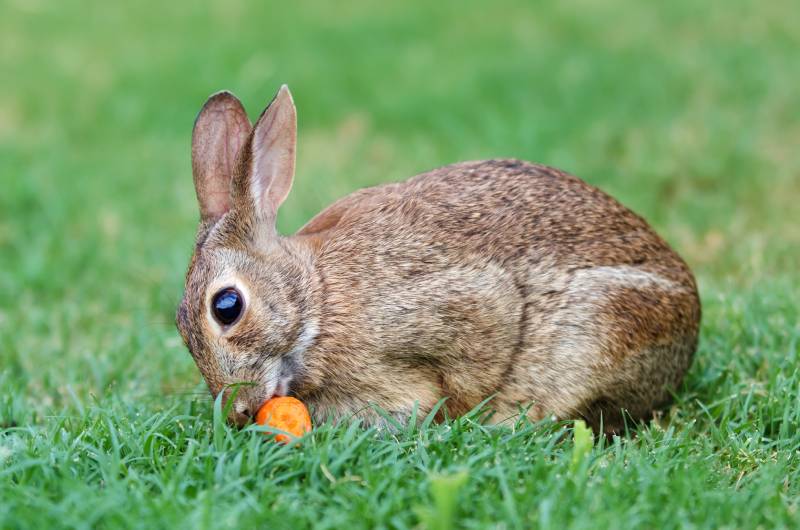Sussex Rabbit: Facts, Care, Diet, Pictures & More

Updated on

Are you considering adding a rabbit to your family? If so, the Sussex rabbit is definitely worth considering. These adorable creatures are known for their friendly and gentle nature, making them ideal pets for both adults and children. Not only are they great companions but they are also easy to care for and require minimal upkeep. In this article, we’ll take a closer look at the Sussex rabbit breed, exploring their temperament, traits, and sharing some adorable pictures that are sure to make you fall in love with these furry critters. So, whether you’re a seasoned rabbit owner or considering getting your first pet, read on to discover everything you need to know about the charming Sussex rabbit.
| Size: | Medium to large |
| Weight: | Up to 5–7 pounds |
| Lifespan: | 6–8 years |
| Similar Breeds: | Hungarian Giant, Flemish Giant, Continental Giant, Blanc de Bouscat, and Spanish Giant |
| Suitable for: | Active families with room in their home for the rabbit to hop around freely |
| Temperament: | Friendly, sociable, affectionate, playful, vocal |
Sussex rabbits are known for their friendly and sociable personalities. They’re very affectionate and love to be around people. These rabbits are also very playful and enjoy playing with toys and other objects. They’re great with children and make excellent family pets.
One thing to keep in mind is that Sussex rabbits can be quite vocal. They are known to make a variety of sounds, including grunting, purring, and humming. While this can be endearing, it’s important to understand that they may make noise during the night, which could disturb your sleep.
Another thing to consider is that Sussex rabbits are very social animals and do best when they have a companion. If you’re considering getting a Sussex rabbit, it’s a good idea to get two so they can keep each other company.
Sussex Rabbit Breed Characteristics
How Much Do These Rabbits Cost?
The cost of a Sussex rabbit can vary depending on a few different factors. The age of the rabbit, its pedigree, and its overall health can all play a role in determining the price. Generally speaking, you can expect to pay anywhere from $50 to $300 for a Sussex rabbit.
It’s important to note that the cost of the rabbit is just one factor to consider when bringing a new pet into your home. You’ll also need to factor in the ongoing cost of food, bedding, and other supplies, as well as any potential veterinary expenses.
If you’re interested in owning a Sussex rabbit but are unsure about the costs involved, it’s always a good idea to do some research and speak with a reputable breeder or pet store. They can provide you with more information about the breed and what to expect.

Temperament & Intelligence of the Sussex Rabbit
Do These Rabbits Make Good Pets? 👪
One of the best things about Sussex rabbits is their calm and friendly temperament. They have a gentle nature and enjoy being around people, making them great pets for families with children. They’re also easy to train and can learn basic commands, such as coming when called or using a litter box. Sussex rabbits are social animals and thrive in pairs or groups, so it’s best to keep them with another rabbit if possible.
Does This Rabbit Get Along With Other Pets?
Sussex rabbits are generally social and friendly, but their compatibility with other pets depends on the individual animals involved and their personalities. Rabbits are prey animals by nature, so they may be nervous or aggressive around larger animals, such as dogs or cats. However, with proper introduction and supervision, many rabbits can coexist peacefully with other pets.
If you already have a dog or cat and are considering getting a Sussex rabbit, it’s important to introduce them slowly and carefully. Allow the animals to get used to each other’s scents before allowing them to interact face-to-face. You can also try feeding them near each other, so they associate positive experiences with the other animal’s presence.
It’s worth noting that some pets may never get along, despite your best efforts. In these cases, it may be best to keep them separated for everyone’s safety and well-being.
 Things to Know When Owning a Sussex Rabbit
Things to Know When Owning a Sussex Rabbit
Food & Diet Requirements 🥕
Sussex rabbits are a breed of domestic rabbits that require a balanced and nutritious diet to maintain their health and well-being. Their diet should primarily consist of hay, fresh vegetables, and fruits. Hay is a crucial component of their diet as it provides essential fiber that aids in digestion and prevents gastrointestinal problems. Vegetables such as carrots, lettuce, spinach, cabbage, collard or turnip greens, radishes, and kale are excellent sources of vitamins and minerals that are essential for their growth.
However, it’s crucial to note that rabbits have sensitive digestive systems and should not consume large amounts of fruits or vegetables with high sugar content. Fruits such as apples, berries, and bananas can be given in moderation as treats. Additionally, water should always be readily available to ensure proper hydration.
Commercial rabbit pellets can also be given as a supplement to their diet. However, these should not be the primary source of their nutrition. It’s essential to choose high-quality pellets that are free from additives, preservatives, and other harmful chemicals.
Habitat & Hutch Requirements 🏠
The ideal habitat for Sussex rabbits should be spacious, clean, and well-ventilated. The hutch should be large enough to allow the rabbit to move around freely, but not so large that the rabbit feels lost or overwhelmed. The hutch should also provide adequate protection from the elements, as well as predators.
When it comes to the flooring of the hutch, it’s recommended to use a solid surface such as wood or plastic, as wire flooring can cause discomfort and injury to the rabbit’s feet. The hutch should also be equipped with a nesting box for the rabbit to retreat to when they need privacy or rest. In addition to this, Sussex rabbits require ample opportunities for exercise and play. Providing them with toys and activities that encourage movement and mental stimulation is important for their overall health.
It’s also important to keep in mind that rabbits are social animals and thrive in pairs or groups. Therefore, if you plan on keeping multiple Sussex rabbits, it’s recommended to keep them in pairs or groups of compatible rabbits.
Exercise & Sleeping Needs 🐇
Sussex rabbits are a breed of domestic rabbits that require regular exercise and adequate sleeping conditions for their physical and mental well-being. Like all rabbits, Sussex rabbits are active animals that need sufficient space to move around and engage in natural behaviors such as hopping, running, and digging. It’s recommended that Sussex rabbits be allowed at least 3–4 hours of exercise time outside of their cage every day. This can be achieved by providing a large, secure enclosure or a rabbit-proofed room where they can play and explore.
Also, Sussex rabbits require adequate sleeping conditions to maintain their health. Rabbits are crepuscular animals, which means they are most active during dawn and dusk and tend to sleep during the day and night. So, it’s important that Sussex rabbits have a quiet and dark sleeping area where they can rest undisturbed. A cozy, comfortable bed with plenty of soft bedding material is also essential for their comfort.
Overall, meeting the exercise and sleeping needs of Sussex rabbits is vital for their physical and mental health. Providing them with enough space to exercise and a comfortable sleeping area will ensure that they are thriving and healthy.
Training 🥎
Training Sussex rabbits can be a rewarding experience for both the rabbit and the owner. So here are some tips for training Sussex rabbits:
- Start early: It’s best to start training Sussex rabbits when they’re young, which ideally is about 8 or 9 weeks old. This will help them get accustomed to human interaction and make them more receptive to training.
- Use positive reinforcement: Positive reinforcement is a key element in training Sussex rabbits – just like with dogs and cats. Rewarding good behavior with treats, praise, and affection will help reinforce positive behavior and make training more effective.
- Be patient: Training takes time and patience. Do not expect immediate results, rabbits are intelligent, but they don’t communicate or respond in the same way that dogs and cats do. So, take small steps and gradually increase the difficulty level of training exercises.
- Keep sessions short: These rabbits have a short attention span, so it’s important to keep training sessions short. Aim for 10–15 minutes per session and try to schedule multiple sessions throughout the day.
- Be consistent: Consistency is super important in training these rabbits. Use the same commands and techniques every time you train your rabbit, so they can learn to associate certain behaviors with specific commands.
- Socialize your rabbit: Socializing your rabbit is an important part of training. Expose your rabbit to different people, pets, and environments so they can learn to adjust to new situations. Take them out of the house when you can.
- Use a clicker: Yes, clicker training is a popular method of training rabbits as well. A clicker is a small device that makes a clicking sound when pressed, which can be used to signal good behavior.
Grooming ✂️
Like any other rabbit, these bunnies require regular grooming to maintain their health and wellbeing.
Brushing Regularly
The first step in grooming your Sussex rabbit is to brush them regularly. These rabbits have a thick coat that can easily become matted and tangled if not brushed regularly. You should brush your rabbit at least once a week using a soft-bristled brush or comb. Start at the head and work your way down to the tail, being careful not to pull on any tangles or mats. If you encounter a particularly stubborn tangle or mat, use a pair of scissors to carefully cut it out. (Note: You can buy complete grooming kits on Amazon.)
Nail Trimming
Another important aspect of grooming your Sussex rabbit is to trim their nails. Rabbits’ nails grow continuously and can become overgrown if not trimmed regularly. Overgrown nails can cause your rabbit pain and discomfort and can also lead to health problems such as arthritis. You should trim your rabbit’s nails every 6 to 8 weeks using a pair of sharp nail clippers. Be sure to only trim the tip of the nail, as cutting too close to the quick can cause bleeding and pain.
Ear Cleaning
In addition to brushing and nail trimming, you should also clean your rabbit’s ears regularly. Rabbits are prone to ear infections, so it is important to keep their ears clean and dry. To clean your rabbit’s ears, moisten a cotton ball with warm water or a gentle ear cleaning solution, and gently wipe the inside of each ear. Be careful not to insert anything into the ear canal, as this can cause damage or infection.
Bathing
Finally, be sure to give your rabbit regular baths to keep their coat clean and healthy. However, rabbits are sensitive to water and can easily become chilled or stressed during a bath. To bathe your rabbit, fill a shallow basin (about the size of a foot soaker) with warm water and add a small amount of rabbit-safe shampoo. Gently wet your rabbit’s coat with a cup or spray bottle, being careful not to get water in their ears or eyes. Apply the shampoo and work it into a lather, then rinse thoroughly with warm water. After the bath, wrap your rabbit in a towel and gently pat them dry.

Lifespan and Health Conditions 🏥
While these rabbits are generally healthy, several serious diseases can affect them. Let’s look at some of the most common ones:
- Dental issues
- Gastrointestinal issues
- Skin issues
- Myxomatosis
- Rabbit hemorrhagic disease
- Pasteurellosis
- Coccidiosis
Minor Conditions:
- Dental Issues: One of the most common minor health issues that affects these rabbits is actually dental problems. Rabbits have continuously growing teeth, and if they don’t wear down naturally, they can become overgrown, leading to dental serious problems. Signs of dental problems in Sussex rabbits include drooling, difficulty eating, and weight loss. To prevent dental problems, it’s essential to provide your rabbit with a healthy diet that includes hay, fresh vegetables, and fruits as mentioned earlier.
- Gastrointestinal Issues: Another minor health issue that affects Sussex rabbits is digestive problems. Rabbits have a sensitive digestive system and can develop gastrointestinal stasis or blockage if they don’t receive enough fiber or hydration. Signs of digestive problems in Sussex rabbits include loss of appetite, bloating, and diarrhea. To prevent digestive problems, it’s essential to provide your rabbit with a diet rich in fiber and hydration, such as hay and fresh water.
- Skin Issues: Skin problems are also common minor health issues that affect Sussex rabbits. Rabbits are prone to skin infections, mites, and fleas that can cause itching, hair loss, and scabs. Regular grooming and hygiene practices can help prevent skin problems in Sussex rabbits. It’s also important to keep your rabbit’s living area clean and free of parasites.
Serious Conditions:
- Myxomatosis: One of the most common diseases that affect Sussex rabbits is myxomatosis. This is a viral disease that is spread by fleas, mosquitoes, and other biting insects. Signs of myxomatosis include swelling around the eyes, mouth, and ears, as well as fever, lethargy, and loss of appetite. Unfortunately, there is no cure for myxomatosis, and the disease is often fatal.
- Rabbit Hemorrhagic Disease: Another serious disease that can affect Sussex rabbits is rabbit hemorrhagic disease (RHD). This is a highly contagious viral disease that affects the liver and other organs in rabbits. Signs of RHD include fever, lethargy, loss of appetite, and sudden death. There is no cure for RHD, and the disease can be spread through direct contact with infected rabbits or through contaminated food, water, or bedding.
- Pasteurellosis: Pasteurellosis is another serious disease that can affect Sussex rabbits. This is a bacterial infection that can cause respiratory problems, including sneezing, coughing, and difficulty breathing. It can also cause abscesses and other infections throughout the body. Pasteurellosis can be transmitted through contact with infected rabbits or through contaminated food or water.
- Coccidiosis: Another serious disease that can affect Sussex rabbits is coccidiosis, which is a parasitic infection that causes diarrhea and other digestive problems, and ear mites, which can cause itching, head shaking, and other ear-related problems.
In order to prevent these serious diseases from affecting your Sussex rabbits, it’s important to keep their living quarters clean and sanitary and to provide them with a healthy diet and regular veterinary care.

Male vs Female
While male and female Sussex rabbits share many similarities, there are some key differences between the two sexes. One of the most noticeable differences between male and female Sussex rabbits is size. Generally speaking, male rabbits tend to be larger than females. This difference in size is most noticeable when the rabbits are fully grown. Mature male Sussex rabbits can weigh up to 10 pounds, while females generally weigh around 7–8 pounds.
Another difference between male and female Sussex rabbits is their behavior. Male rabbits tend to be more territorial and aggressive than females. This is especially true during breeding season when males may become more aggressive in order to establish dominance over other males. Female Sussex rabbits, on the other hand, tend to be more docile and nurturing.
One of the most significant differences between male and female Sussex rabbits is their reproductive anatomy. Male rabbits have external testicles that are located beneath the tail. Female rabbits have a genital opening located just below the anus. Female Sussex rabbits can become pregnant as early as 4 months of age and typically give birth to litters of 4 to 8 kits.
The 3 Little-Known Facts About Sussex Rabbit
1. They’re a Really Old Breed
Sussex rabbits are one of the oldest breeds of domestic rabbits, with a history dating back to the 19th century. They were developed in England and were originally used for meat and fur production. However, due to their friendly nature and attractive appearance, they soon became popular as pets.
2. They Stand Out Physically
Sussex rabbits have a distinctive appearance that sets them apart from other breeds. These rabbits have a compact, muscular body with short, round ears and a broad head. Their fur is dense and soft and can be found in a variety of colors including black, blue, chocolate, and fawn.
3. They’re Super Gentle
These rabbits are known for their gentle temperament and make great pets for families with children. They are social animals that enjoy human interaction and can be trained to do simple tricks. However, they do require regular grooming to keep their fur in good condition.
 Final Thoughts
Final Thoughts
If you’re looking for an affectionate, medium to large-sized rabbit to keep as a pet, the Sussex rabbit is a great choice. Sussex rabbits are friendly and tend to get along well with other pets and are great for families with children. These rabbits are prone to certain health conditions, but with good breeding and proper veterinary care, Sussex rabbits have a good lifespan for a rabbit and can live healthy lives.
Featured Image Credit to: JumpStory

 Things to Know When Owning a Sussex Rabbit
Things to Know When Owning a Sussex Rabbit








